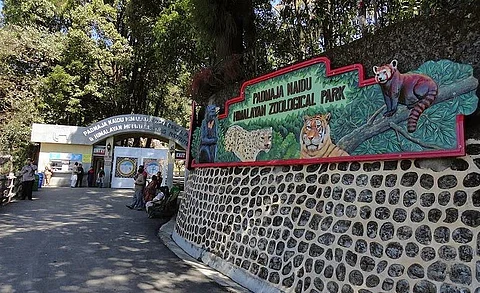
- Destinations
- Experiences
- Stay
- What's new
- Celebrating People
- Responsible Tourism
- CampaignsCampaigns
- Subscribe
- Buy Now

Darjeeling’s Padmaja Naidu Himalayan Zoological Park has established India’s first frozen zoo. The facility is designed to store the genetic material of various Himalayan species at extremely low temperatures.
It is a collaboration between the zoo and Hyderabad-based Centre for Cellular and Molecular Biology that aims to preserve DNA samples in liquid nitrogen at minus 196 degrees Celsius to maintain their genetic information for future use. The cryogenic conservation aims to ensure that even if species like red pandas, snow leopards, gorals, mishmi takins, among others dwindle in the wild, their genetic blueprints remain intact.
A frozen zoo is a genetic cryobank that stores genetic material (like DNA, sperm, eggs, and embroyos) from animals that are typically endangered and are on the verge of extinction. The genetic material is stored in liquid nitrogen tanks at extremely low temperatures (minus 196 degrees Celsius) for long-term preservation.
The primary goal of a frozen zoo is to safeguard the genetic diversity of these species, especially those facing extinction threats.
Bengal’s Chief Wildlife Warden Debal Roy claims that tissue samples will be collected from both captive and wild animals, including those who die naturally or due to accidents such as road kills.
According to the director of the zoo, Basavaraj Holeyachi, a dedicated lab has been set up to store gametes and DNA of these endangered species. The genetic sampling takes place at minus 20 degrees Celsius while the bio-banking process at minus 196 degrees Celsius to prevent cell degradation. In Darjeeling, the two-step process of sampling and banking began in July, last year.
In the future, this stored genetic material could potentially aid assisted reproduction techniques including the possibility of using surrogate mothers to revive the vanishing species.
Other techniques including artificial insemination, embryo transfer, or In-Vitro Fertilisation can also be used to revive many species in times when habitats are shrinking and climate change is rapidly changing their ecosystem. This preservation could ensure that many endangered species like the red pandas and snow leopards do not become a part of the forgotten past, like many others.
There are less than a dozen frozen zoos across the world. The first and most popular frozen zoo was created by Kurt Benirschke in 1975 at the Institute for Conservation Research in San Diego. Currently, the institute stores a collection of 8,400 samples across 800 species and subspecies.
However, the world's first inter-species transfer using an embryo that had been frozen and thawed was produced in 1999 at the Audubon Institute Center for Research of Endangered Species. Jazz, an African wild cat kitten was born to his surrogate mother, Cayenne, and was a result of the first successful interspecies transfer of a frozen embryo. The mother was a domestic tabby cat.
